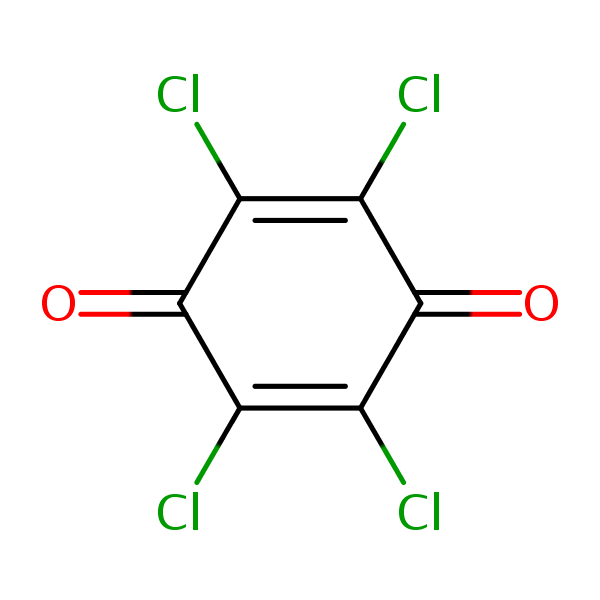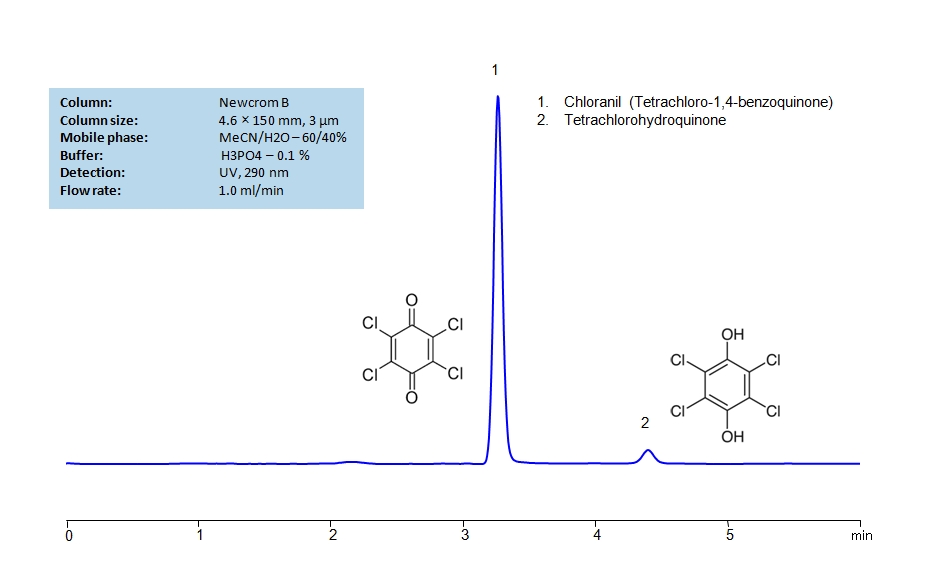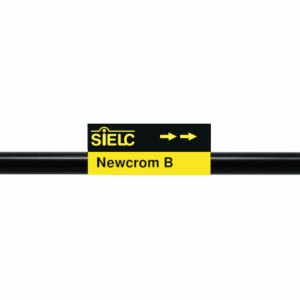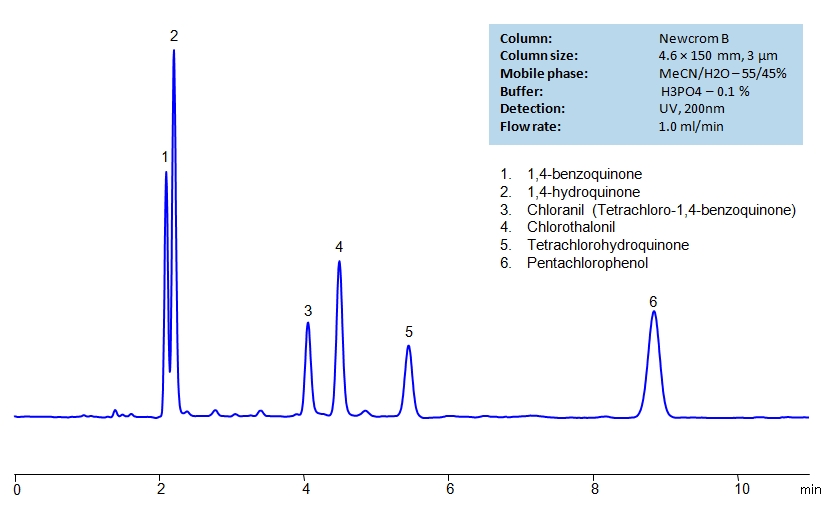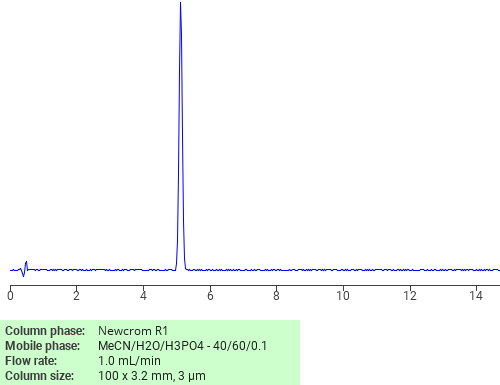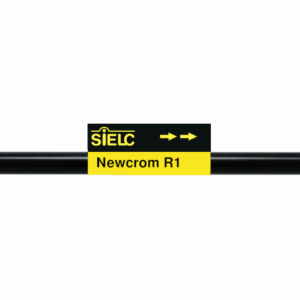| CAS Number | 118-75-2 |
|---|---|
| Molecular Formula | C6Cl4O2 |
| Molecular Weight | 245.861 |
| InChI Key | UGNWTBMOAKPKBL-UHFFFAOYSA-N |
| LogP | 2.28 |
| Synonyms |
|
Applications:
HPLC Separation of Chloranil and Tetrachlorohydroquinone on Newcrom B Column
February 6, 2020
HPLC Method for Chloranil, Tetrachlorohydroquinone on Newcrom B by SIELC Technologies
High Performance Liquid Chromatography (HPLC) Method for Analysis of Chloranil, Tetrachlorohydroquinone.
Chloranil, also known as tetrachloro-1,4-benzoquinone, is a quinone with the chemical formula C6Cl4O2. It is a planar molecule that functions as an oxidant. It serves as a hydrogen acceptor and is more electrophilic than quinone. Chloranil is used to test for free secondary amines, which is useful to check for the presence of proline derivatives. Commercially, it is a precursor to dyes.
Tetrachlorohydroquinone, also known as TCHQ, is a chlorinated organic compound with the chemical formula C6H2Cl4O2. It is a metabolote of the biocide pentachlorophenol. It causes damage to cells by increasing reactive oxygen species (ROS). It is harmful if swallowed and can cause serious eye damage.
Chloranil, Tetrachlorohydroquinone can be retained and analyzed using the Newcrom B stationary phase column. The analysis utilizes an isocratic method with a simple mobile phase consisting of water and acetonitrile (MeCN) with a phosphoric acid buffer. Detection is performed using UV.
| Column | Newcrom B, 4.6 x 150 mm, 3 µm, 100 A, dual ended |
| Mobile Phase | MeCN/H2O – 60/40% |
| Buffer | H3PO4 – 0.1% |
| Flow Rate | 1.0 ml/min |
| Detection | UV 290 nm |
| Class of Compounds | Haloaromatics, Hydrophobic |
| Analyzing Compounds | Chloranil, Tetrachlorohydroquinone |
Application Column
Newcrom B
Column Diameter: 4.6 mm
Column Length: 150 mm
Particle Size: 3 µm
Pore Size: 100 A
Column options: dual ended
Tetrachlorohydroquinone

HPLC Separation of Haloaromatics and Quinones on Newcrom B Column
February 6, 2020
HPLC Method for Benzoquinone, Hydroquinone, Chlorothalonil, Chloranil, Pentachlorophenol, Tetrachlorohydroquinone on Newcrom B by SIELC Technologies
High Performance Liquid Chromatography (HPLC) Method for Analysis of Benzoquinone, Hydroquinone, Chlorothalonil, Chloranil, Pentachlorophenol, Tetrachlorohydroquinone.
1,4-benzoquinone, also known as para-quinone, is a compound with the formula C6H4O2. It is typically used as a precursor to hydroquinone, which is a reducing agent and antioxidant. It also serves as a dehydrogenation reagent and dienophile in Diels-Alder reactions.
1,4-hydroquinone is an aromatic derivative of benzene with the chemical formula C6H6O2. It is often used in skin whitening, although it has been banned by the United States Food and Drug Administration for over-the-counter use due to being a potential carcinogen. It can cause a variety of disease including but not limited to ochronosis. thyroid follicular cell hyperplasias, mononuclear cell leukemia, and adenomas. Agencies across the world encourage research into other agents to treat hyperpigmentation. You can find detailed UV spectra of hydroquinone and information about its various lambda maxima by visiting the following link.
Chloranil, also known as tetrachloro-1,4-benzoquinone, is a quinone with the chemical formula C6Cl4O2. It is a planar molecule that functions as an oxidant. It serves as a hydrogen acceptor and is more electrophilic than quinone. Chloranil is used to test for free secondary amines, which is useful to check for the presence of proline derivatives. Commercially, it is a precursor to dyes.
Chlorothalonil is a compound with a variety of uses as a fungicide, wood protectant, pesticide, and acaricide. It is used predominantly on peanuts, potatoes, and tomatoes. Outside of agriculture, it is also used in paints, resins, emulsions, and coatings. It’s chemical formula is C8Cl4N2.
Tetrachlorohydroquinone, also known as TCHQ, is a chlorinated organic compound with the chemical formula C6H2Cl4O2. It is a metabolote of the biocide pentachlorophenol. It causes damage to cells by increasing reactive oxygen species (ROS). It is harmful if swallowed and can cause serious eye damage.
Pentachlorophenol is a manufactured chemical with the chemical formula C6HCl5O. It is most often used as herbicide, insecticide, fungicide, algaecide, and disinfectant. Exposure to it can cause damage to liver, kidney, blood, lungs, eyes, skin, and mouth. It is classified as a probable human carcinogen.
Benzoquinone, Hydroquinone, Chlorothalonil, Chloranil, Pentachlorophenol, Tetrachlorohydroquinone can be retained and analyzed using the Newcrom B stationary phase column. The analysis utilizes an isocratic method with a simple mobile phase consisting of water and acetonitrile (MeCN) with a phosphoric acid buffer. Detection is performed using UV.
| Column | Newcrom B, 4.6 x 150 mm, 3 µm, 100 A, dual ended |
| Mobile Phase | MeCN/H2O – 55/45% |
| Buffer | H3PO4 – 0.1% |
| Flow Rate | 1.0 ml/min |
| Detection | UV 200 nm |
| Class of Compounds | Haloaromatics, Quinones, Hydrophobic |
| Analyzing Compounds | Benzoquinone, Hydroquinone, Chlorothalonil, Chloranil, Pentachlorophenol, Tetrachlorohydroquinone |
Application Column
Newcrom B
Column Diameter: 4.6 mm
Column Length: 150 mm
Particle Size: 3 µm
Pore Size: 100 A
Column options: dual ended
Chloranil
Chlorothalonil
Hydroquinone
Pentachlorophenol
Tetrachlorohydroquinone

Separation of Chloranil on Newcrom R1 HPLC column
February 16, 2018
Chloranil can be analyzed by this reverse phase (RP) HPLC method with simple conditions. The mobile phase contains an acetonitrile (MeCN), water, and phosphoric acid. For Mass-Spec (MS) compatible applications the phosphoric acid needs to be replaced with formic acid. Smaller 3 µm particles columns available for fast UPLC applications. This liquid chromatography method is scalable and can be used for isolation impurities in preparative separation. It also suitable for pharmacokinetics.
Application Column
Newcrom R1
The Newcrom columns are a family of reverse-phase-based columns. Newcrom A, AH, B, and BH are all mixed-mode columns with either positive or negative ion-pairing groups attached to either short (25 Å) or long (100 Å) ligand chains. Newcrom R1 is a special reverse-phase column with low silanol activity.
Select options